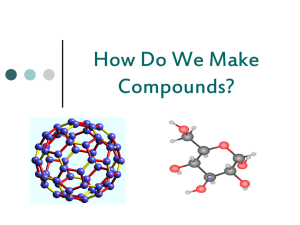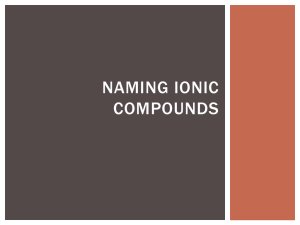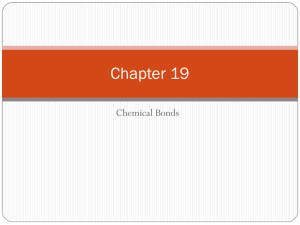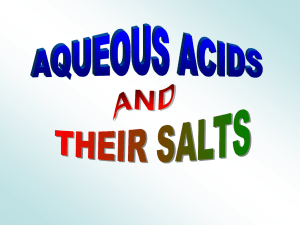Naming Compounds wit..
advertisement
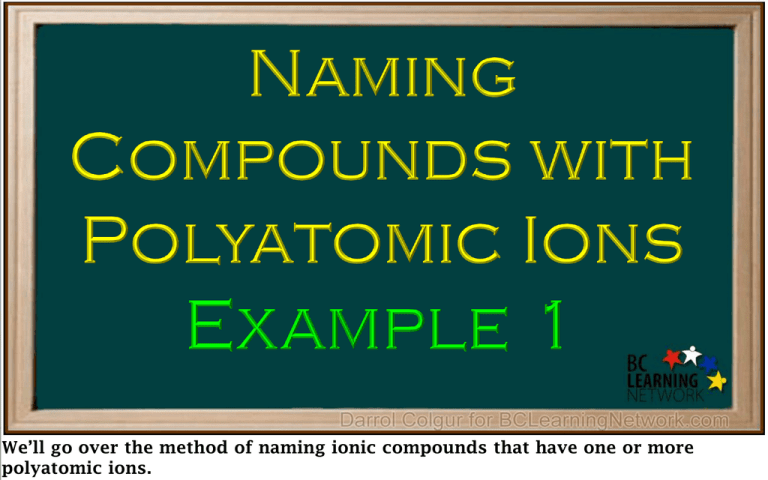
We’ll go over the method of naming ionic compounds that have one or more polyatomic ions. Any time a formula has more than two elements in it, or more than two capital letters, Any time a formula has more than two elements in it, or more than two capital letters, Any time a formula has more than two elements in it, or more than two capital letters, it must contain at least one polyatomic ion. it must contain at least one polyatomic ion. MgSO4 Al(NO3)3 Lets consider the formula MgSO4, NH4ClO3 MgSO4 3 Elements Al(NO3)3 NH4ClO3 It has 3 elements in it: magnesium, sulphur, and oxygen, so it must contain a polyatomic ion. Formulas and Charges of Common Ions The polyatomic ions that we’ll be using in this course are shaded on this table. If we are given a formula with more than 2 elements in it, we look on this table for any polyatomic ions that are in the formula. Formulas and Charges of Common Ions MgSO4 The formula we’re working with is MgSO4, Formulas and Charges of Common Ions MgSO4 SO4 in the formula (click) is from the polyatomic ion sulphate, SO4 2 minus Formulas and Charges of Common Ions MgSO4 Mg in the formula is from (click) the single metal ion Mg 2+ MgSO4 Polyatomic Al(NO3)3 Ion So MgSO4 contains the polyatomic ion sulphate, SO4. NH4ClO3 Al(NO3)3 MgSO4 Now we’ll consider the formula Al, NO3 in brackets, 3 NH4ClO3 Al(NO3)3 MgSO4 3 Elements NH4ClO3 This formula also contains 3 elements, (click) aluminum, nitrogen, and oxygen. So it must have a polyatomic ion in it. Formulas and Charges of Common Ions Al(NO3)3 The formula we’re working with is Al(NO3)3 Formulas and Charges of Common Ions Al(NO3)3 We see that NO3 in the formula (click) is from the polyatomic ion nitrate, NO3 minus. Formulas and Charges of Common Ions Al(NO3)3 And The Al in the formula Formulas and Charges of Common Ions Al(NO3)3 Is from the single metal ion Al 3plus Al(NO3)3 Polyatomic MgSO4 Ion So Al(NO3)3 contains the polyatomic ion nitrate NO3 NH4ClO3 NH4ClO3 MgSO4 4 Elements We see that this formula contains 4 elements: (click) Nitrogen, hydrogen, chlorine, and oxygen Formulas and Charges of Common Ions NH4ClO3 The formula we’re working with is NH4ClO3. Formulas and Charges of Common Ions NH4ClO3 Looking on the table, we see that NH4 in the formula, Formulas and Charges of Common Ions NH4ClO3 Comes from the positive polyatomic ion ammonium, NH4 plus Formulas and Charges of Common Ions NH4ClO3 And ClO3 in the formula Formulas and Charges of Common Ions NH4ClO3 Comes from the negative polyatomic ion chlorate, ClO3 minus NH4ClO3 2 Polyatomic MgSO4 Ions So the formula NH4ClO3 contains 2 polyatomic ions, (click) NH4 or ammonium, and ClO3, or chlorate. Rules for Naming Compounds with Polyatomic Ions Now that we’ve shown you how to find polyatomic ions in formulas, lets look at the rules for naming compounds with polyatomic ions. Rules for Naming Compounds with Polyatomic Ions 1. The name of a polyatomic ion does not change when it is used in a compound name. 2. Single elements follow the same naming rules as they do in other compounds. The first rule is, the name of a polyatomic ion does not change in any way when it is used in a compound name. Its name is the same in a compound as it is on an ion table. Rules for Naming Compounds with Polyatomic Ions 1. The name of a polyatomic ion does not change when it is used in a compound name. 2. Single elements follow the same naming rules as they do in other compounds. The second rule is, single elements that are not in polyatomic ions, follow the same rules as they do in other compounds. Name the compound with the formula NH4Br The best way to learn how to name compounds with polyatomic ions, is to see several examples. Here, we’re asked to name the compound NH4Br Name the compound with the formula NH4Br NH4Br 3 Elements We see that NH4Br has 3 elements (click) nitrogen, hydrogen, and bromine. Therefore, it must contain a polyatomic ion. Name the compound with the formula NH4Br NH4Br Looking on the table, we see that NH4 in the formula, Name the compound with the formula NH4Br NH4Br Is from the polyatomic ion ammonium, NH4 plus. Name the compound with the formula NH4Br NH4Br ammonium bromide Names of polyatomic ions don’t change when they are part of a compound name, so the first part of the name (click), is ammonium. Name the compound with the formula NH4Br NH4Br ine ammonium bromide The formula ends with the single element Br Name the compound with the formula NH4Br NH4Br ine ammonium bromide Which the periodic table tells us is bromine. Name the compound with the formula NH4Br NH4Br ine ammonium bromide So we’ll note down bromine here. Name the compound with the formula NH4Br NH4Br For a non-metal at the end of a formula, the name ends in “ide” ine ammonium bromide But for a non-metal element at the end of a formula, the name must be changed to end in –ide. Name the compound with the formula NH4Br NH4Br ine ammonium bromide ide So we replace the “ine” with “ide” Name the compound with the formula NH4Br NH4Br ide ammonium bromide And we’re left with the name bromide. Name the compound with the formula NH4Br On the ion table NH4Br ide ammonium bromide Alternately, we can find Br minus on the ion table, and we see that it’s name is bromide, so if a non-metal ion is on our ion table, we can just copy the name directly from there. Name the compound with the formula NH4Br NH4Br ide ammonium bromide So the final answer is (click) the name of this compound is ammonium bromide

